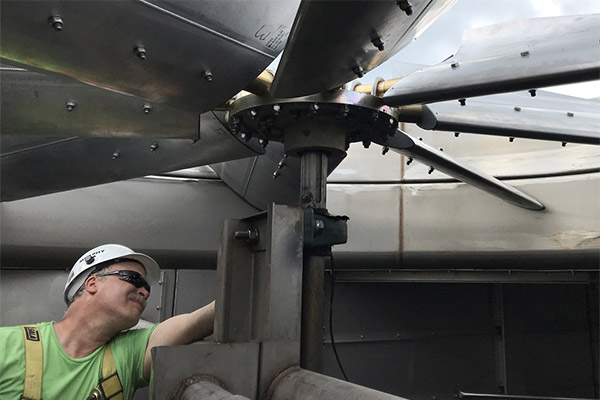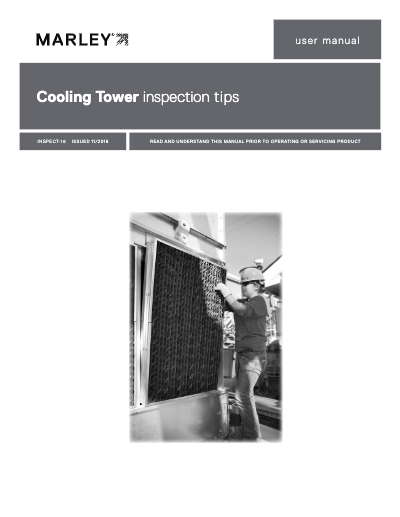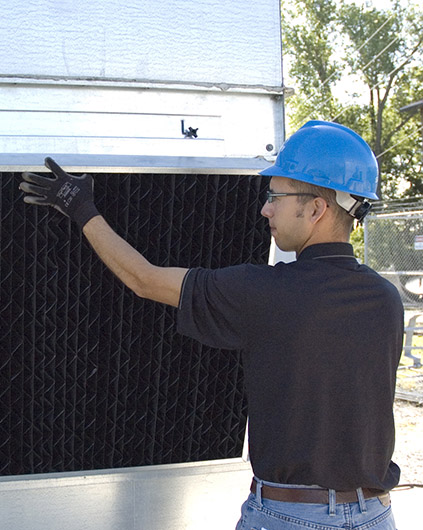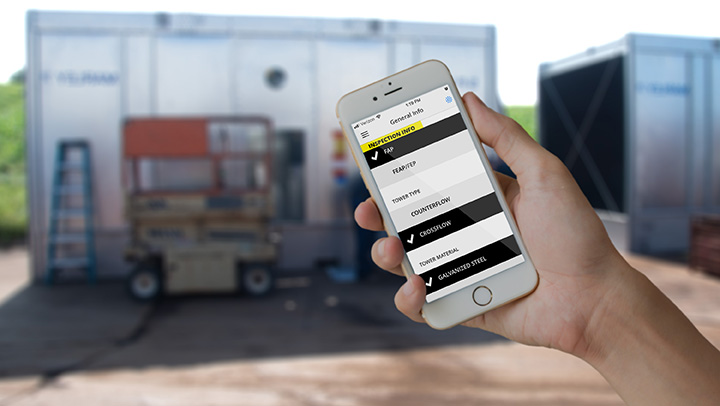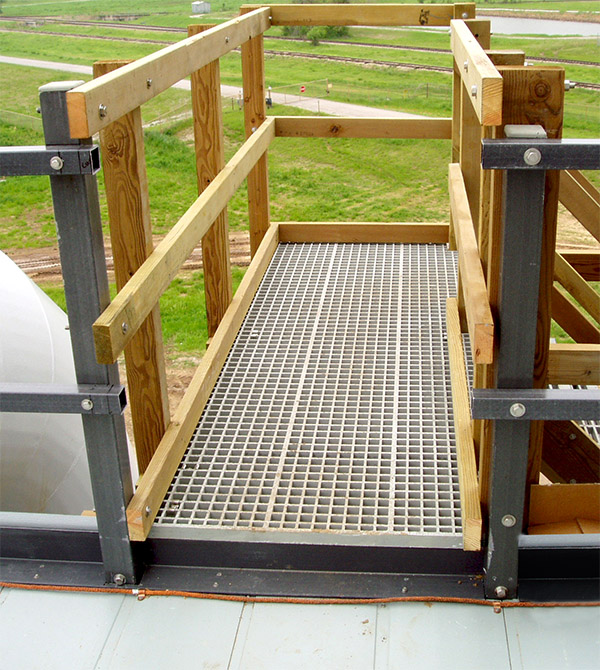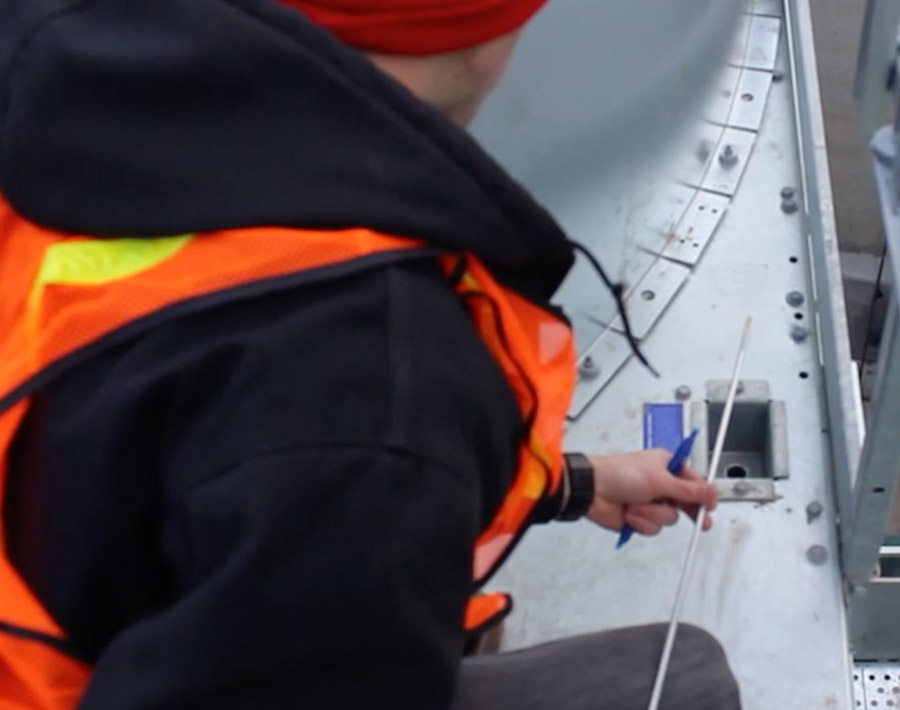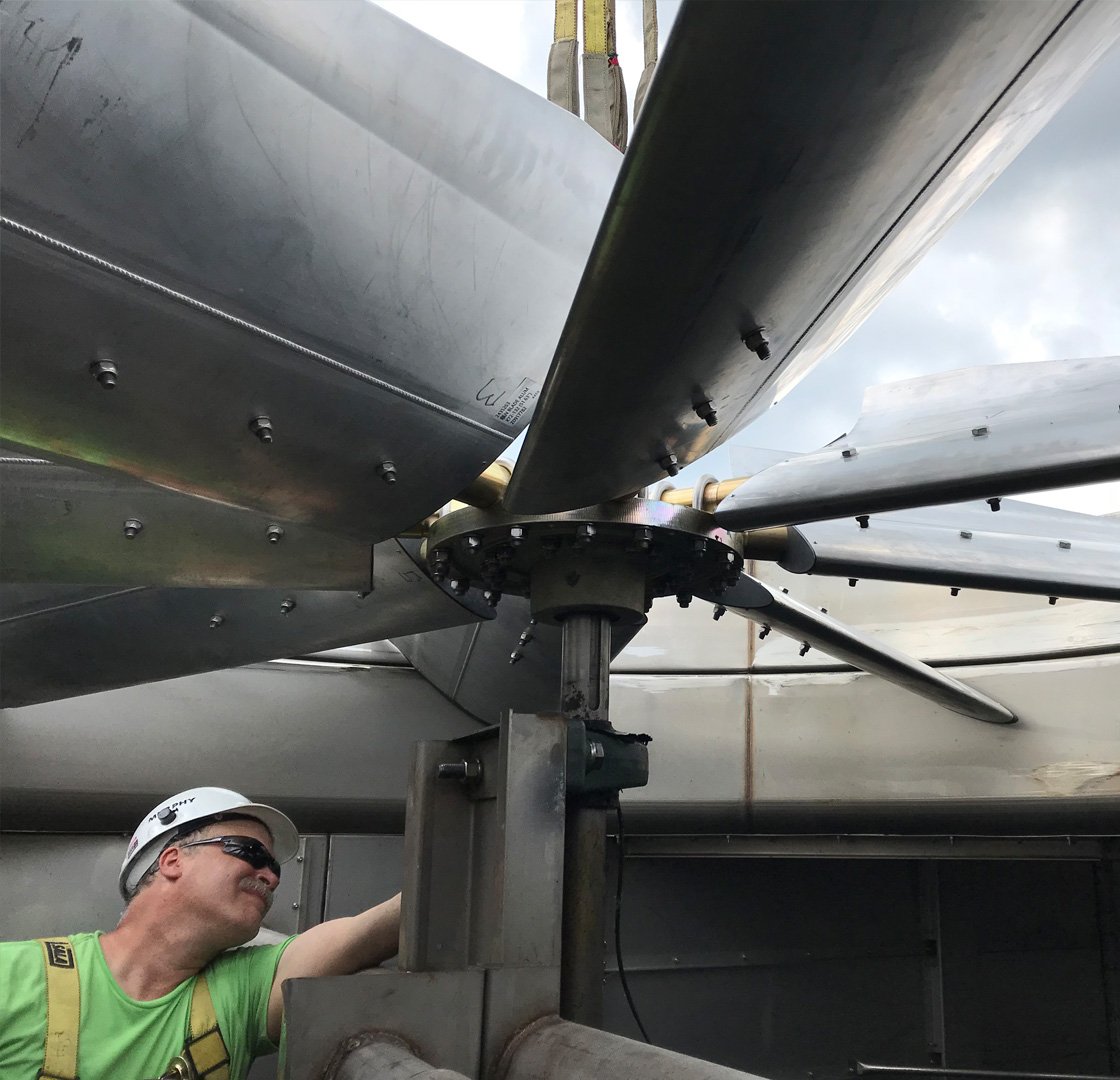Cooling Tower Inspection Tips
Scheduling a regular, thorough inspection is an essential step in safeguarding the efficiency and lifespan of your cooling tower.
When you’ve filled out the checklist, use the results to help plan your cooling tower repair and maintenance. Always refer to your tower’s user manual if you have specific questions about your cooling tower. Your Marley sales representative will be happy to help you with parts and service or to guide you toward a qualified service contractor.
Use our online rep finder, or use this inspection request form!
Download The Checklist
Schedule An Inspection Today!
Use this form to request a cooling tower inspection, and your local
Marley® representative will contact you with more information.
Safety and Health
Before starting a cooling tower inspection it is important to identify all potential safety and health hazards associated with the work and identify how each hazard will be eliminated or controlled. Planning ahead helps alert workers to potential safety hazards and take appropriate preventive action. Always follow safety and health regulations published by local authorities. Use the following general guidelines for basic worker protection.
Personal Protective Equipment
Always follow local Safety and Health regulations regarding personal protective equipment (PPE). At minimum, cooling tower workers should wear a hard hat, safety glasses or goggles, work gloves, and high-top leather boots with nonslip soles. Fall protection should be provided as required. When a situation calls for climbing the cooling tower structure , workers should be equipped with a full-body harness and two shockabsorbing lanyards of at least six feet in length. Two lanyards allow movement while providing fall protection at all times. Safety belts or single lanyard systems do not provide adequate fall protection.
Cooling Tower Hygiene
An unclean tower can be an amplifier of unhealthy biological agents. It is important to periodically inspect an operating cooling tower for good biological control and to have a proactive water treatment plan in place, per ANSI/ASHRAE Standard 188 and Guideline 12. The inspection should include, at a minimum, visual evaluation of the condition of the water and the distribution basins. Good biological control is indicated by clean, clear water with no green or brown algae below the water line. Poor control is detected by cloudy, dirty, or foul-smelling water. Also look for rust-colored corrosion “pockets.” These pockets may be filled with black liquid that smells like rotten eggs. If observed conditions indicate poor biological control, the tower should be thoroughly cleaned and the water treatment system evaluated. Clean cooling towers result from practicing biological testing and using effective biological control procedures, which also mitigate corrosion and scaling.
Inspection
Tower Casing
Look for leaks, cracks, holes or general deterioration, including air leaks between adjoining panels. Make sure that hardware attaching the casing to the structure is tight and in good condition. Inspect steel casing for corrosion or scale buildup and examine wood casing for signs of wood decay, including soft rot or plywood delamination. Look for evidence of brittleness or cracking in fiberglass casing. Make sure that access doors are in good working order and that access doors are shut tightly when tower is in operation. If your budget allows, consider replacing ACB (asbestos cement board) casing immediately, regardless of its condition. In handling and/or disposing of ACB or ASB material, it is recommended that you contact the Federal Agency, OSHA, EPS, as well as the local and state agencies for information concerning specific state regulations and requirements for handling and the disposal of asbestos wastes.
Structure
Inspect the structure of a steel tower for evidence of corrosion—particularly any loss of metal. Spot check the tightness of bolted joints. Look closely for signs of corrosion near welded joints on galvanized steel towers. Look for signs of wood deterioration, including through cracks, fractures, or decay in wood members. Inspect wood members both visually and by tapping with a hammer. A dull, low pitch sound indicates softness, while a higher pitched sharp sound indicates good solid wood. If you find soft spots, carefully probe with an ice pick or similar device. Pay particular attention to the wood around steel or cast iron fasteners and connectors, as well as the bottom of columns. Spot check the tightness of bolted structural joints. Inspect joint connectors for evidence of corrosion or other signs of deterioration. Check the assembled joints of a fiberglass or plastic tower to be sure that hardware is tight and in good condition. Look for evidence of tearing or cracking in the structure.
Check the general condition of the fan deck material, noting any steel corrosion or wood decay. Make sure the fan deck support members are in good condition and that connections between the fan deck and the supports are tight. Look for air leaks between adjoining fan deck panels. Loose fan deck overlays are a tripping hazard. Be sure that overlays are properly attached and that the overlay material is in good condition. Consider replacing ACB overlays immediately, regardless of condition.
Stairway
Look for evidence of wood decay or steel corrosion. Check for loose treads, handrails, or deteriorated stringers. Make sure all bolted connections are tight and that hardware is in good condition.
Ladder and Handrail
Check general condition of material and make sure that all connections between the ladder and the tower are tight and in good condition. Check the welds on steel and aluminum ladders.
Interior Walkway
Look for broken or deteriorated treads and rails on wood or fiberglass walkways. Inspect steel walkways for evidence of corrosion. Check the tightness of connections between the walkway and the tower structure. Pay particular attention to any damage or deterioration that may pose a potential safety hazard for operating and maintenance personnel.
Cold Water Basin
Check for excessive buildup of sludge and accumulated debris that can provide an ideal breeding ground for bacteria. Check condition of sump, sump screen, and anti-cavitation device (if one is used). Sump screen should be free of trash. Note particularly any corrosion or loss of metal in cold water basin components. Inspect wood, steel and fiberglass basins carefully for any signs of leaks or breakdown of sealing material.
Distribution Basin
Check for deterioration of the basic material. Check wood for decay, and check for corrosion of steel. Look for leaks between adjoining panels. Inspect the integrity of basin support members. Check tightness of bolted joints in steel or fiberglass basins.
Piping
Inspect iron pipe for corrosion and loss of coating material. Examine all supports to ensure their integrity for continued service. Spot check for leaks and for tightness of bolted joints. Look for signs of deterioration on PVC or fiberglass pipe.
Basin Flow-Control Valves
Inspect valve components for corrosion or signs of wear. Operate valve manually through its full range of travel and reset the valves to balance water flow to all basin sections.
Spray Nozzles
Check for clogging or signs of internal wear. If necessary, temporarily remove a nozzle and disassemble it to look for internal clogging. Be sure that all nozzle components (such as removable splash plates) are in place and working properly. Look for any loss of material resulting from corrosion or erosion. Check for adequate connection to branch pipe or distribution basin floor.
Fill comes in two general types: splash and film.
Splash fill consists of wood or plastic bars in various shapes, supported in a fixed spacing and orientation, usually using a wire or fiberglass grid. Ceramic bricks are another type of splash fill. For each splash fill, check the condition of the splash bars themselves. Look for sagging, broken or decaying splash bars or excessive buildup of scale. Look also for fallen or misplaced splash bars. Be sure that all supporting grids are in place and evenly spaced in the tower. Check the coating on steel grids, the condition of the welds on stainless wire grids, and the general condition of fiberglass grids. If a section of grid shows excessive deterioration, it should be replaced. Also, examine the tower members that support the grid itself. In the event you need to order parts, note the following:
- Material of splash bars and grids
- The horizontal and vertical spacing between adjacent splash bars
- Whether the splash bars are installed parallel or perpendicular to the louver face
- Shape of the splash bar (wood lath, T-bar, V-bar, M-bar, half-round, etc.)
Film fill consists of multiple parallel formed sheets, either hung in the tower or resting on fixed support members. Check for buildup of scale, algae, or other contaminants on the surface of the sheets. Also check for erosion, sagging, torn sheets, or evidence of ice damage. Check the condition of support members. Note the sheet material and spacing in case you plan to order parts. In either case, consider replacing asbestos fill immediately. You’ll benefit from improved performance that modern high-efficiency fill designs offer.
Drift (Mist) Eliminators
Cleanliness and effectiveness of drift eliminators maximize water containment and greatly reduce drift emissions. Make sure that all air passages are clear of debris, and as clean as possible. Check that all components are properly installed. Check condition of seals to assure that water can’t bypass the eliminators through deteriorated or missing seals. Wood blades and frames are subject to severe conditions, and should be checked for rot and decay. In case you need to order replacement parts, note the material and configuration of drift eliminators. The major types are wood blades, plastic blades, and PVC cellular configurations, including eliminators molded on the fill sheets.
Louvers
Make sure that all louvers are in place. Look for any deterioration of the base material, such as wood rot or corrosion of steel louvers. Check for excessive scale buildup or biological growth. Check the condition of louver support members, and of the connections between the louvers (supports) and the tower itself. Note the material, arrangement and vertical spacing of louvers. Typical varieties include plywood, steel, ACB, fiberglass and cellular configurations molded on the fill sheets. Consider replacing ACB louvers immediately regardless of condition.
Belt Drive Fan System
Check the condition of the pulleys, looking for any corrosion or loss of metal in the pulley grooves or on the webs. Make sure that the bushings holding the pulleys on the shafts are tight and in good condition. Check for proper belt tension and alignment. Look for signs of wear, such as checks and gouges, indicating that belts should be changed. Check the fan shaft bearing lubricant, and re-lubricate if necessary. Make sure that shafts and seals are in good condition. Check for loose or damaged bearings. Make sure that all connections between the bearing housing and the support are tight and in good condition. Check the support itself for evidence of corrosion or other damage, and check the tightness of connections between the support and the tower structure.
Geareducer® Gear Drive
Turn the fan off, check the oil level and add or replace oil as necessary. Drain an oil sample and look for evidence of foreign material such as water, metal shavings, or sludge. Check for oil leaks around seals (particularly input pinion seals) and replace the seal if leakage seems excessive. Check backlash by rotating the pinion shaft back and forth, noting the amount of free rotation before the gear teeth engage fully. Check endplay by pulling up and down on a fan blade tip, noting the amount of movement in the gear drive output shaft. Some amount of backlash and endplay are necessary for proper gear life. If you have doubts about your gear drive, consult a qualified service contractor. Make sure that the outside of the case is free from excessive deposits that may inhibit cooling. Check that all hardware connecting the gear drive to the support is tight and in good condition.
Direct Drive Fan System
Make sure that the fan bushing is tight on the motor shaft and that the bushing and its hardware are in good condition. Check the joints between the motor mount and its support.
Check alignment using any approved method, such as a dial indicator or optical device. Look for evidence of corrosion or other damage on the tube, particularly near any welds. Check all connections between the tube and the flex elements, and between the coupling halves and the motor and gear drive shafts. Examine metallic flex elements very carefully for signs of corrosion or fatigue. Examine elastomeric flex elements for cracks, brittleness or other signs of wear. Many driveshafts consist of a single span. However, some still include two shafts together with an intermediate bearing housing support. If your driveshaft includes a mid-span bearing, check the bearing carefully, adding lubricant as necessary. Check alignment of both shafts and make sure that bearing hold-down hardware is tight and in good condition. If you must replace any component in a two-shaft system, you should investigate replacing the entire system with a single-span shaft, which will reduce your maintenance costs dramatically.
Fan
If your tower has centrifugal blowers, check for broken or missing blades. Look for corrosion or erosion of the blades, particularly near any welds between the blades and the end plates. Check the condition and tightness of the hub and the bushings between the hub and shaft. Propeller fans may be either fixed-pitch, with welded or riveted connections between the blades and hub; or adjustable pitch, having bolted connections between the blades and hub and some means of readjusting blade pitch angle. Check fixed-pitch fan blades for corrosion or erosion. Carefully examine the connections between the blades and hub. Check the condition and tightness of the bushing between the hub and shaft. Check the blades and hub of adjustable-pitch fans for signs of corrosion, erosion, or excessive buildup of deposits. Carefully measure the pitch angle of each blade, and readjust blades to the manufacturer’s recommended pitch angle within +1/2°. Check the tightness and condition of the hardware attaching the blades to the hub. Tighten as necessary using manufacturer’s recommended procedures. Examine the connections between the hub cover (if there is one) and the fan hub.
Fan Cylinder (Shrouds)
Check overall condition of the material, paying particular attention to any welds in steel shrouds. Check the condition and tightness of all assembly and hold-down hardware. Look for any leaks between adjoining stack segments. Measure fan blade tip clearance all around the cylinder, using the longest fan blade. Adjust tip clearance by adjusting the cylinder or support according to the manufacturer’s instructions.
Mechanical Equipment Support
Examine all steel components for corrosion or loss of metal, particularly near welds and bearing surfaces. Check tightness of connections between the mechanical equipment and the support; and between the support and the tower structure. Check all bolted connections in the support itself for proper tightness and condition of hardware. On wood towers, look for evidence of iron rot wherever the support contacts the structure. On steel and fiberglass towers, check all bolted connections between the support and the structure itself.
Makeup Valve
Operate the float valve or float switch manually to make sure that it opens and closes properly.

